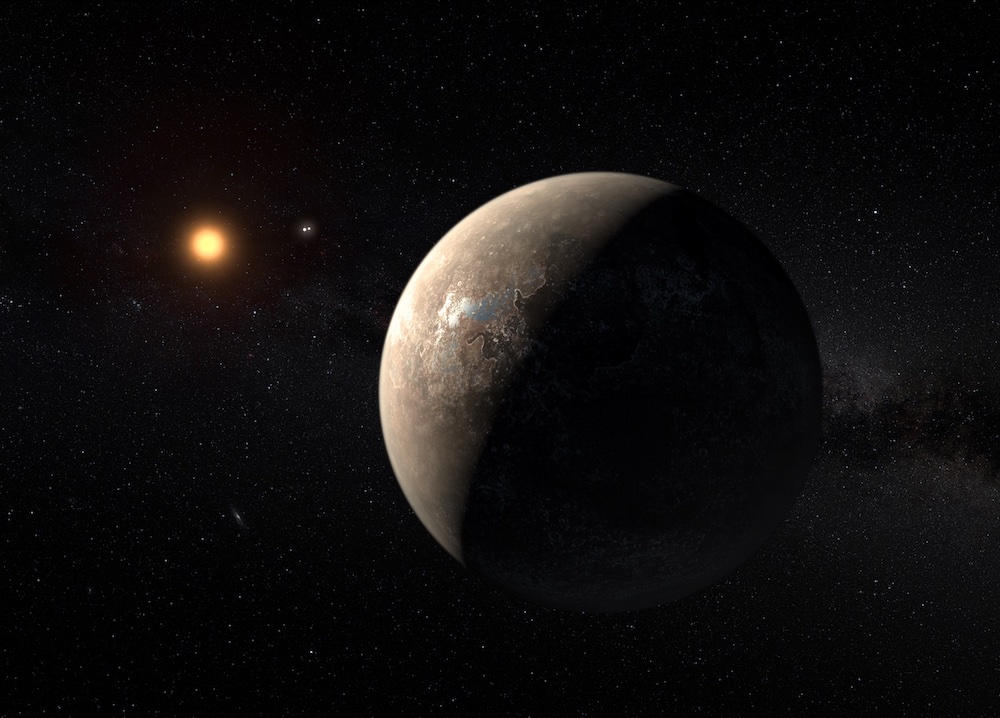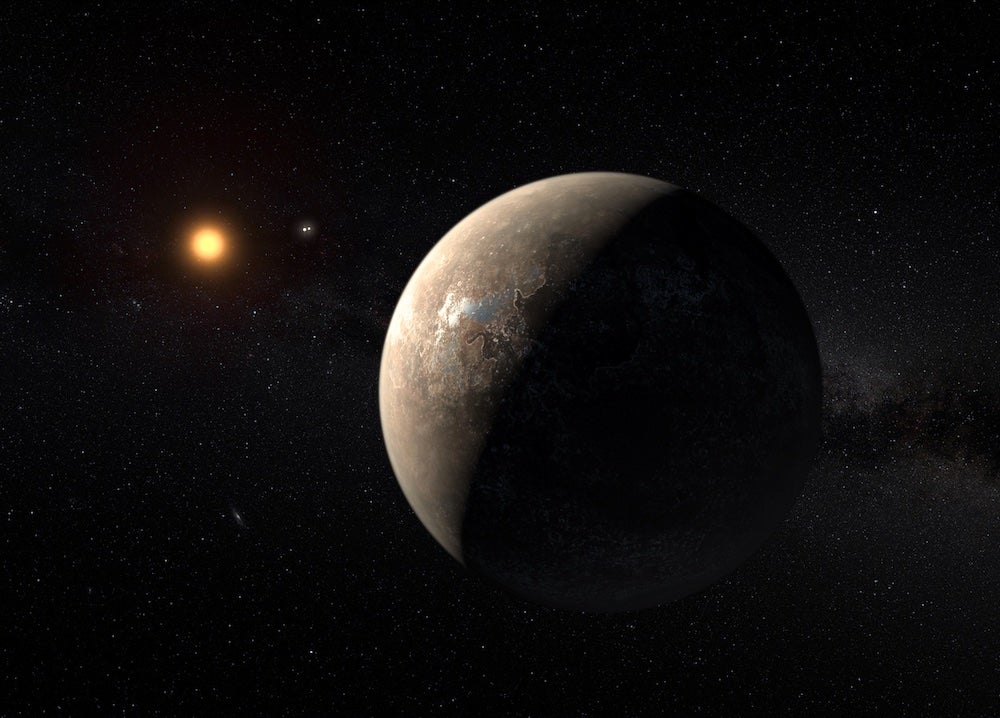
The red dwarf Proxima Centauri is the closest star to the Sun. It appears in the upper left of this artist’s concept, with its planet Proxima b in the foreground. The double star that appears between them in the background is Alpha Centauri A and B (also known as Rigil Kentaurus and Toliman, respectively). (Credit: ESO/M. Kornmesser)
If you want to study the stars, there’s no better place to start than close to home. After all, the nearest star is just 93 million miles (150 million kilometers) away: the Sun. Its daily presence and predictable motions through the sky may make it seem like a boring, steady companion. But up close, it’s an incendiary tempest of roiling plasma, erupting with brilliant solar flares and mottled by darker sunspots — not to mention it’s the only star known (so far) to host a planetary system that includes an inhabited world.
An estimated 200 billion trillion or so stars fill the known cosmos, but nearby stars attract a lot of attention from astronomers. “We are somehow attached naturally to things that are close by, to finding out what’s going on right next door,” says astronomer Rodrigo Díaz at the National University of San Martín in Buenos Aires, Argentina, who has helped discover planets that orbit nearby stars. “We grow up in a neighborhood, and as we grow, we expand our sphere of familiarity and go bigger and bigger and bigger.”
In that spirit, it’s worth familiarizing ourselves with our surroundings by examining the 10 stars nearest to our own. They range in color from white-hot to cool red, from twice the mass of the Sun to less than 10 percent its heft. Some of them are bursting with powerful flares. And, as we are beginning to find, some play host to a variety of exoplanets. So, here are our stellar neighbors, in order from nearest to farthest.
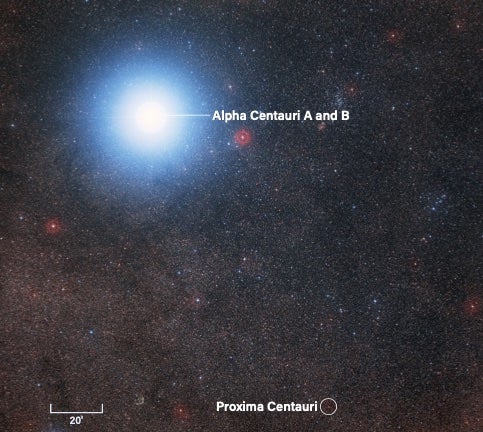
Proxima Centauri
Proxima Centauri, our nearest neighbor, lies a mere 4.25 light-years away. If the Milky Way shrank to the size of the Big Island of Hawaii, then the Sun and Proxima Centauri would be two pinpricks of light separated by the length of a car. In the night sky, the star hides within the enormous constellation Centaurus; despite its proximity to Earth, Proxima Centauri glows too dimly to see with the unaided eye. It only inhabits the sky over the Southern Hemisphere, which means northern stargazers are out of luck.
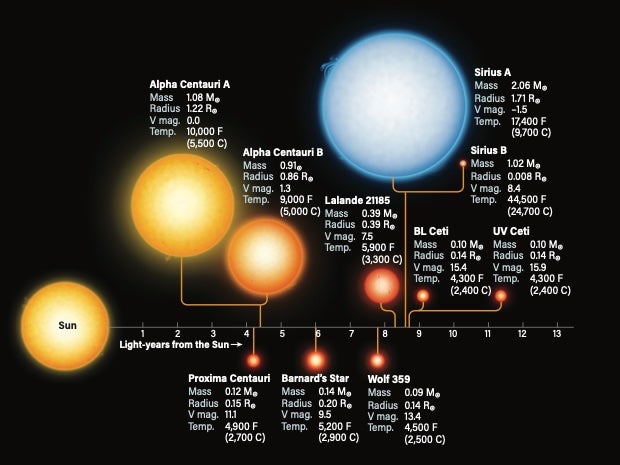
Small and faint, Proxima Centauri is a red dwarf, the most common type of star in the Milky Way. It emits less energy than the Sun and it’s smaller: It measures roughly one-seventh as wide as the Sun and about one-eighth as massive. It’s also a flare star, a type of variable star that can unpredictably and violently shine brightly for short periods of time, sometimes as brief as a few minutes.
Those bright flares mean that it’s unlikely to host a habitable world. So far, astronomers have confirmed one planet in its orbit. Proxima b, discovered in 2016 and confirmed in 2020, is a rocky world about 7 percent more massive than Earth. It orbits in the habitable zone, the right distance from its star for its surface to support liquid water. But that doesn’t mean the planet is habitable: In 2018 the star released a powerful electromagnetic flare. If such flares were common in its past, they could have obliterated anything alive — as well as any atmosphere — on the planet.
Candidate planet Proxima c, which was discovered in 2020, orbits father out and is about six times as massive as Earth. It’s too far from the star to host liquid water. And in February 2022, astronomers reported the signature of a third possible planet, with only a quarter the mass of Earth and so close that it orbits the star every five days.
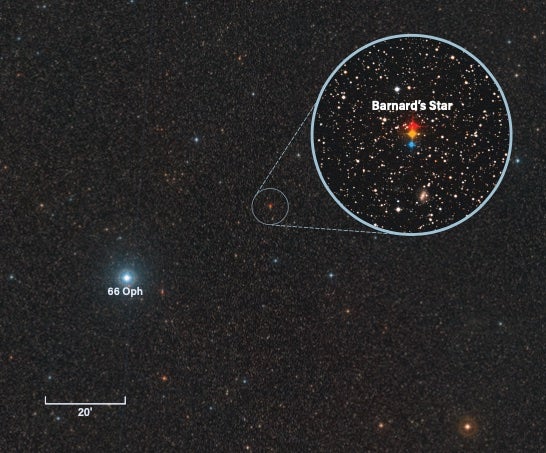
The Alpha siblings
Proxima Centauri isn’t a solo star — it’s actually the outlier in a three-star system. Its binary companions, Alpha Centauri A and B, orbit their mutual center of gravity every 80 years. They’re about 4.35 light-years from Earth and separated from each other by about 23 times the average distance between the Sun and Earth (or about the distance from the Sun to Uranus).
Alpha Centauri, though, is no longer the system’s official name. In 2016, the International Astronomical Union (IAU) officially renamed Alpha Centauri A to Rigil Kentaurus — based on its ancient Arabic name, which means “foot of the Centaur.” (Like Proxima, the star is found in the constellation Centaurus.) It is the larger of the two Alpha Centauri stars and the most Sun-like. It has about 10 percent more mass than the Sun and burns bright yellow. Like the Sun, it is classified as a G2 star and has a surface temperature around 10,000 degrees Fahrenheit (5,500 degrees Celsius).
Its companion star, commonly known as Alpha Centauri B, became Toliman under the IAU’s naming shift of 2016. Toliman is about 10 percent less massive than the Sun and, as a K-type star, glows more orange than yellow. Together, Rigil Kentaurus and Toliman shine as one star and are observable to the naked eye as the third-brightest light in the night sky. With the aid of a telescope, the two can be distinguished from each other.
No planets have been confirmed orbiting The Stars Formerly Known As Alpha Centauri, but in March 2022 astronomers published a model of what an Earth-sized planet might look like in the system’s habitable zone. Their calculations yielded a world similar to Earth in water content but richer in carbons like graphite and diamond, and with a larger iron core and perhaps less plate tectonic activity.
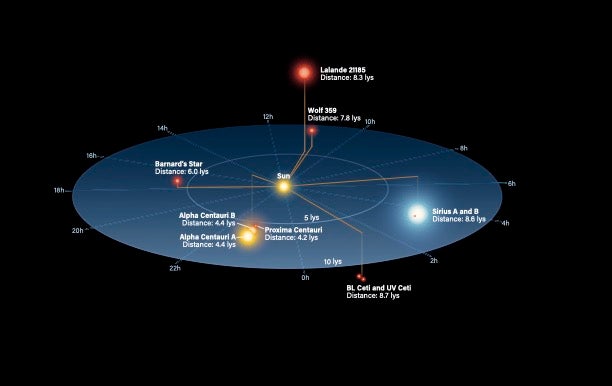
The runaway star
The next closest star, at about 6 light-years away in Ophiuchus, is Barnard’s Star. The star is famous not so much for its composition — it’s a rather small and humdrum red dwarf, like the vast majority of stars — but for its locomotion. Barnard’s Star has the unique distinction of being the fastest-moving star in the sky, a trait first observed by its discoverer, American astronomer Edward Emerson Barnard. It appears to move across the sky — a behavior astronomers call proper motion — at a rate of 10.4″ every year as it zips through space at 310,000 mph (500,000 km/h).
Like Proxima Centauri, Barnard’s Star is a flare star. It’s several billion years old and has a radius one-fifth that of the Sun. Whether the star has a planetary system remains an open question and the subject of a decades-long tug of war in the astronomical community. In the 1960s, Dutch astronomer Peter van de Kamp claimed to have found evidence for two giant, Jupiter-like worlds: Images of the star taken through repeated telescopic observations hinted at wiggles and shivers that suggest the gravity of a nearby planet was tugging on it. But this was dismissed in the 1970s as instrument error when a review of van de Kamp’s photographic plates found that all of the stars in that field of view appeared to wobble in the same way at the same time, corresponding to upgrades to the telescope. A 2018 study claimed strong evidence for a super-Earth, but in 2021 astronomers reported they failed to find a convincing signal.
Science fiction writers certainly want it to be true. Since the 1930s, Barnard’s Star and its phantom planets have figured in books, movies, and video games, including The Hitchhiker’s Guide to the Galaxy.
A wolf in star’s clothing
The next nearest star is the red dwarf Wolf 359, which has also been name-checked prominently in science fiction. In an episode of Star Trek: The Next Generation, the Battle of Wolf 359 resulted in the destruction of dozens of Federation ships by the Borg.
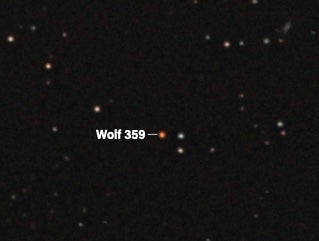
Wolf 359 is a red dwarf in the constellation Leo, about 7.9 light-years away. Despite its proximity, it remains undetectable to the naked eye. It’s one of the smallest stars known — closer in diameter to Jupiter than to the Sun. Like Proxima Centauri and Barnard’s Star, it occasionally flares brightly, and like Barnard’s Star, it moves across the sky with a high proper motion. It was first identified by German astronomer Max Wolf in his catalog of over 1,000 fast-moving stars. The star doesn’t have enough mass to swell and become a red giant, and models suggest that it’s fully convective, which means heat from the center moves all the way to the surface, conveyed by giant masses of plasma.
In 2019, planet hunters searching hundreds of nearby red dwarfs identified two possible worlds in orbit around Wolf 359. One is a cool super-Neptune that orbits once every 2,938 days. The other candidate, closer in, was thought to be a hot super-Earth with a period of only 2.69 days, but subsequent observations have called that planet into question.
Long-sought worlds
Lalande 21185 is one of the brightest red dwarfs close to Earth — though, like others of its kind, it’s still too dim to see with the naked eye. At 8 light-years away, it can be found in the southern part of Ursa Major, and measures a little less than half as large as the Sun in both diameter and in mass. Jérôme Lalande, an 18th-century French astronomer who largely assembled vast catalogs of planetary positions, discovered the star.
It’s also known as Gliese 411, its designation in the Gliese star catalog. Astronomers have floated claims that the star harbors its own planetary system at least since the 1950s, when Peter van de Kamp and his student Sarah Lippincott reported wobbles in its motion. These were subject to the same instrument error as van de Kamp’s discredited reports of planets around Barnard’s Star. Separately, in the 1990s, astronomer George Gatewood predicted a planet with 90 percent the mass of Jupiter. But that, too, has not been borne out.
In May 2019, astronomers including Rodrigo Díaz described new evidence for a super-Earth around Lalande 21185 that orbits about every 13 days and is likely far too hot to be habitable. And in April 2022, astronomers reported evidence for a Neptune-like planet with an orbit of about eight years. (They also described data suggesting a third planet may orbit the star with a period of 215 days.)
Díaz, who helped find that world, says its proximity makes it a tantalizing target for future observing missions. New, enormous telescopes with mirrors larger than 20 meters in diameter are now under construction — including the Extremely Large Telescope and Giant Magellan Telescope, both in Chile — that will have the ability to directly image such worlds and probe their atmospheres.
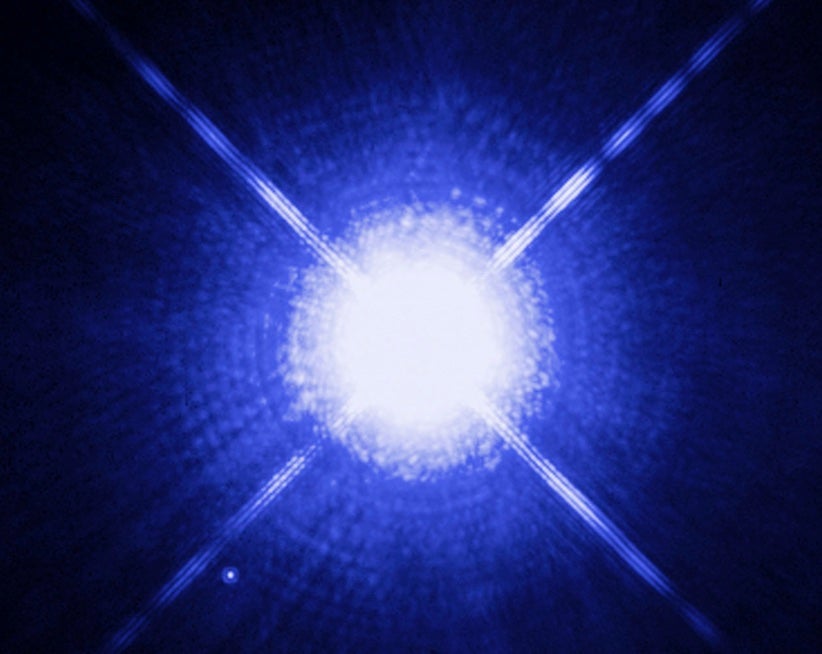
Seriously bright
There may be no star more famous than Sirius A, the brightest star in the sky. It boasts a luminosity more than 25 times that of the Sun and glows blue-white. Its diameter is about 70 percent wider and its mass more than double that of the Sun, and its surface temperature reaches over 17,400 F (9,600 C). But unlike our middle-aged, 4.6-billion-year-old Sun, Sirius A is a relative infant, believed to be only 200 million to 300 million years old, which means it formed about the same time the earliest dinosaurs emerged on Earth.
It gets its other name — the Dog Star — from its prime position in the constellation Canis Major (Latin for “greater dog”). The ancient Egyptians called the star Sothis and attributed the annual flooding of the Nile to it, as it appears first in the summer pre-dawn sky in mid-July.
But Sirius A is only half the story. Like Alpha Centauri, Sirius A is gravitationally bound to a stellar companion, Sirius B. They orbit each other 8.6 light-years away with a period of about 50 years. In the mid-19th century, German astronomer Friedrich Wilhelm Bessel inferred from the wobble of Sirius A that it likely had a tiny companion, but it wasn’t until after Bessel’s death that American astronomer and telescope maker Alvan Graham Clark spied it through a telescope. Sirius B is tiny — about the size of Earth — but its stellar dance with Sirius A suggests it has about the same mass as the Sun. That makes Sirius B a white dwarf, the glowing remnant of a star that’s already burned through its hydrogen fuel.
Curiously, in a.d. 140, the philosopher Ptolemy described Sirius as bright red, leading some astronomers to speculate that Sirius B was then a red giant star, outshining Sirius A before it collapsed to its present diminutive state. This seems unlikely, however, based on the timescales of stellar evolution.
No planets have yet been observed around Sirius A or B. Astronomers have flirted with the idea of a low-mass third star in the system since the late 19th century, suggested by apparent orbital irregularities; but recent observations from the Hubble Space Telescope have eliminated that notion.
Meet the Cetis
The last two stars on the list are BL Ceti and UV Ceti, both dim, red, main sequence stars in a binary system roughly 8.6 light-years away within the northern constellation Cetus the Whale. Discovered in the late 1940s when Dutch-American astronomer Willem Luyten was compiling a list of stars with high proper motion, they’re also known as Luyten 726–8A and Luyten 728–8B (or collectively as Luyten 726-8 or Gliese 65). They orbit their common center of mass once every 26.5 years at about 5.5 times the Earth-Sun separation, though the distance between them expands and shrinks dramatically over that time because the orbit is so eccentric.
UV Ceti and BL Ceti are physically nearly identical. Each has about one-tenth the mass of the Sun and a radius about 14 percent that of the Sun. Both are flare stars; UV Ceti, which has the more violent temper, was the first known example of this category. Shortly after the star’s discovery in 1948, astronomers observed UV Ceti flare to become four magnitudes brighter, its effective temperature soaring to over 10,000 C (17,500 F). After the outburst, the star quickly dimmed.
Today, flare stars are often called UV Ceti variable stars. Over the decades, researchers have observed flares erupting from both stars in Luyten 726-8 in other wavelengths besides visible light, like X-rays and infrared. While stellar variability can arise from many causes, the flares on UV Ceti stars are thought to be the closest analogue to the flares on our own Sun, driven by the stars’ wound-up magnetic fields.
Keeping up appearances
We aren’t likely to be able to visit even our closest neighboring star systems anytime soon. But our telescopes have granted us valuable insight into them and their activity.
It’s also worth pondering how our Sun might appear to any inhabitants of these neighboring systems. With its flares and rich diversity of planets, it would likely be an enticing object for any extraterrestrial astronomers — especially those based around Wolf 359, from which Earth appears to transit the Sun. Among the denizens of this corner of the galaxy, our home star may just be the most fascinating of them all.

